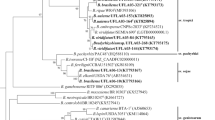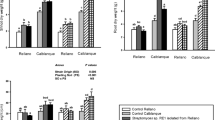Summary
Experiments were conducted to determine the extent to which populations of Bradyrhizobium sp. strain Tal 209SR were suppressed by the antagonistic activity of a Streptomyces sp. isolated from a highly weathered tropical soil. The activity of the actinomycete was evaluated in culture medium in the presence or absence of clay minerals and in the soil from which the actinomycete was isolated after sterilization by gamma-irradiation. The presence of the actinomycete in culture medium was associated with a significant reduction in the density of Bradyrhizobium sp. (Tal 209SR). Nevertheless, the density of the Bradyrhizobium sp. surviving in the medium in the presence of the actinomycete was much higher than that normally observed when comparable densities of rhizobia are introduced into non-sterile soils. The presence of the antagonistic actinomycete in culture medium was associated with a drastic decrease in the optical density of the medium. This decrease was accompanied by a significant decrease in the insoluble exopolysaccharide content of the medium in addition to the significant decrease in bradyrhizobial cells. The actinomycete did not appear to significantly influence the growth and survival of the test Bradyrhizobium sp. in sterile soil. The inability of the actinomycete to significantly antagonize the test bacterium in sterile soil was not adequately explained by the presence of clay minerals.
Similar content being viewed by others
References
Cunningham SD, Munns DN (1984) The correlation between extracellular polysaccharide production and acid tolerance in Rhizobium. Soil Sci Soc Am J 48:1273–1276
Danso SKA, Keya SO, Alexander M (1975) Protozoa and the decline of Rhizobium populations added to soil. Can J Microbiol 21:884–895
Dazzo FB, Truchet GL, Sherwood JE, Hrabak EM, Gardiola AG (1982) Alteration of the trifoliin A-binding capsule of Rhizobium trifolii 0403 by enzymes released from clover roots. Appl Environ Microbiol 44:478–490
Ghai SK, Hisamatsu M, Amemura A, Harada T (1982) Production and chemical composition of extracellular polysaccharides of Rhizobium. J Gen Microbiol 122:33–40
Gottlieb D (1976) The production and role of antibiotics in soil. J Antibiot 29:988–1000
Griffin DM (1972) Ecology of soil fungi. Syracuse University Press, Syracuse, NY
Habte M, Manujunath A (1988) Influence of phenamiphos on the vesicular-arbuscular mycorrhizal symbiosis in Leucaena leucocephala. Biol Fertil Soil 5:313–316
Habte M, Barrion M (1984) Interaction of Rhizobium sp. with toxin-producing fungus in culture medium and in a tropical soil. Appl Environ Microbiol 47:1080–1083
Habte M, Alexander M (1975) Protozoa as agents responsible for the decline of Xanthomonas campestris in soil. Appl Environ Microbiol 29:159–164
Habte M, Alexander M (1978) Protozoan density and the ecoexistence of protozoan predators and bacterial prey. Ecology 59:140–146
Halverson LJ, Stacy G (1986) Signal exchange in plant-microbe interactions. Microbiol Rev 50:193–225
Hattingh MJ, Louw HA, (1966) The antagonistic effects of soil microorganisms isolated from the root region of clovers on Rhizobium trifolii. S Afr J Agr Sci 9:239–252
Osa-Afiana LO, Alexander M (1982) Differences among cowpea rhizobia in tolerance to high temperature and desiccation in soil. Appl Environ Microbil 43:435–439
Patel JJ (1974) Antagonism of actinomycetes against rhizobia. Plant Soil 41:395–402
Pugashetti BK, Angle JS, Wagner GH (1982) Soil microorganisms, antagonistic towards Rhizobium japonicum. Soil Biol Biochem 14:45–49
Slack JM, Gerencser MA (1975) Actinomyces-filamentous bacteria, biology and pathogenecity. Burgess, Minneapolis.
Solheim B, Fjellheim KF (1984) Rhizobial polysaccharide-degrading enzymes from roots of legumes. Physiol Plant 62:11–17
Trinick MJ, Parker CA, Palmer MJ (1983) Interaction of the microflora from nodulation problem and non-problem soils toward Rhizobium spp. on agar culture. Soil Biol Biochem 15:295–301
Vincent JM (1970) A manual for the practical study of the rootnodule bacteria. IBP Handbook No. 15. Blackwell, Oxford
Van Schreven DA (1964) The effect of some actinomycetes on rhizobia and Agrobacterium radiobacter. Plant Soil 21:283–303
Vidor C (1982) Microbial constraints to legume symbiosis. In: Graham PH, Harris SC (eds) Biological nitrogen fixation technology for tropical agriculture. Centro International de Agricultura Tropical, Cali, pp 182–195
Waksman SA (1967) The actinomycetes, a summary of current knowledge. Ronald Press, New York
Waksman SA, Schatz A (1946) Soil enrichment and development of antagonistic microorganisms. J Bacteriol 51:305–316
Author information
Authors and Affiliations
Additional information
Hawaii Institute of Tropical Agriculture and Human Resources Journal Series No. 3129
Rights and permissions
About this article
Cite this article
Barrion, M., Habte, M. Interaction of Bradyrhizobium sp. with an antagonistic actinomycete in culture medium and in soil. Biol Fert Soils 6, 306–310 (1988). https://doi.org/10.1007/BF00261018
Received:
Issue Date:
DOI: https://doi.org/10.1007/BF00261018




